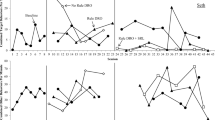Abstract
Procedures classified as positive reinforcement are generally regarded as more desirable than those classified as aversive—those that involve negative reinforcement or punishment. This is a crude test of the desirability of a procedure to change or maintain behavior. The problems can be identified on the basis of theory, experimental analysis, and consideration of practical cases. Theoretically, the distinction between positive and negative reinforcement has proven difficult (some would say the distinction is untenable). When the distinction is made purely in operational terms, experiments reveal that positive reinforcement has aversive functions. On a practical level, positive reinforcement can lead to deleterious effects, and it is implicated in a range of personal and societal problems. These issues challenge us to identify other criteria for judging behavioral procedures.
Similar content being viewed by others
References
Azrin, N. H. (1961). Time out from positive reinforcement. Science, 8133, 382–383.
Baron, A. (1991). Avoidance and punishment. In I. H. Iversen & K. A. Lattal (Eds.), Experimental analysis of behavior (Part 1, pp. 173–217). Amsterdam: Elsevier.
Baum, W. M. (1974). Chained concurrent schedules: Reinforcement as situation transition. Journal of the Experimental Analysis of Behavior, 22, 91–101.
Cohen, P. S., & Campagnoni, F. R. (1989). The nature and determinants of spatial retreat in the pigeon between periodic grain presentations. Animal Learning & Behavior, 17, 39–48.
Crosbie, J. (1998). Negative reinforcement and punishment. In K. A. Lattal & M. Perone (Eds.), Handbook of research methods in human operant behavior (pp. 163–189). New York: Plenum.
de Souza, D. D., de Moraes, A. B. A., & Todorov, J. C. (1984). Shock intensity and signaled avoidance responding. Journal of the Experimental Analysis of Behavior, 42, 67–74.
Dinsmoor, J. A. (1983). Observing and conditioned reinforcement. Behavioral and Brain Sciences, 6, 693–728. (Includes commentary)
Fantino, E. (1977). Choice and conditioned reinforcement. In W. K. Honig & J. E. R. Staddon (Eds.), Handbook of operant behavior (pp. 313–339). Englewood Cliffs, NJ: Prentice Hall.
Ferster, C. B. (1967). Arbitrary and natural reinforcement. The Psychological Record, 17, 341–347.
Hineline, P. N. (1984). Aversive control: A separate domain? Journal of the Experimental Analysis of Behavior, 42, 495–509.
Jwaideh, A. R., & Mulvaney, D. E. (1976). Punishment of observing by a stimulus associated with the lower of two reinforcement frequencies. Learning and Motivation, 7, 211–222.
Michael, J. (1975). Positive and negative reinforcement, a distinction that is no longer necessary; or a better way to talk about bad things. Behaviorism, 3, 33–44.
Michael, J. (1993). Concepts and principles of behavior analysis. Kalamazoo, MI: Association for Behavior Analysis.
Morse, W. H., & Kelleher, R. T. (1977). Determinants of reinforcement and punishment. In W. K. Honig & J. E. R. Staddon (Eds.), Handbook of operant behavior (pp. 174–200). Englewood Cliffs, NJ: Prentice Hall.
Perone, M., & Courtney, K. (1992). Fixed-ratio pausing: Joint effects of past reinforcer magnitude and stimuli correlated with upcoming magnitude. Journal of the Experimental Analysis of Behavior, 57, 33–46.
Perone, M., & Galizio, M. (1987). Variable-interval schedules of timeout from avoidance. Journal of the Experimental Analysis of Behavior, 47, 97–113.
Scripture, E. W. (1895). Thinking, feeling, doing. Meadville, PA: Flood and Vincent.
Sidman, M. (1989). Coercion and its fallout. Boston: Authors Cooperative.
Sizemore, O. J., & Maxwell, F. R. (1985). Selective punishment of interresponse times: The roles of shock intensity and scheduling. Journal of the Experimental Analysis of Behavior, 44, 355–366.
Skinner, B. F. (1971). Beyond freedom and dignity. New York: Knopf.
Skinner, B. F. (1983). A matter of consequences. New York: Knopf.
Thompson, D. M. (1965). Time-out from fixed-ratio reinforcement: A systematic replication. Psychonomic Science, 2, 109–110.
Author information
Authors and Affiliations
Corresponding author
Additional information
This paper is based on the presidential address delivered to the Association for Behavior Analysis convention in Toronto, Ontario, May 2002.
Rights and permissions
About this article
Cite this article
Perone, M. Negative effects of positive reinforcement. BEHAV ANALYST 26, 1–14 (2003). https://doi.org/10.1007/BF03392064
Published:
Issue Date:
DOI: https://doi.org/10.1007/BF03392064



